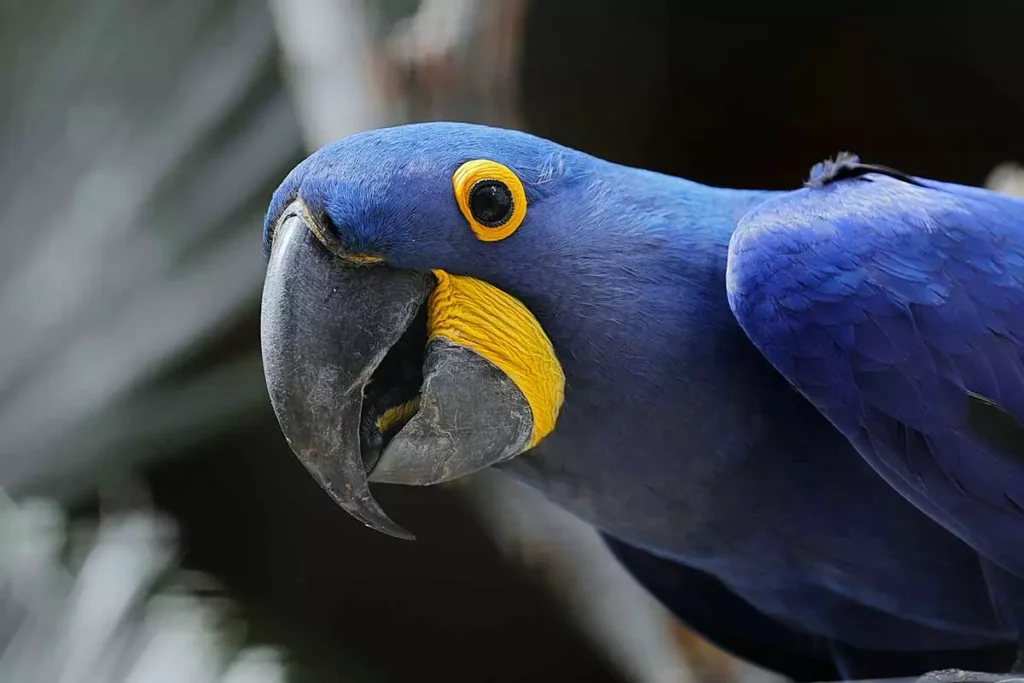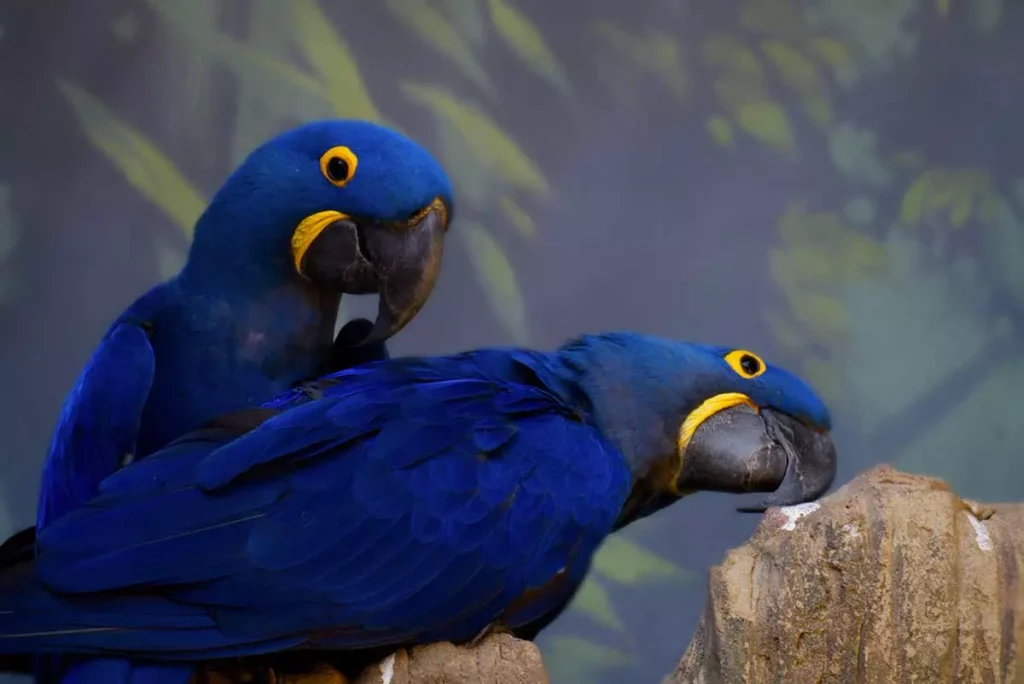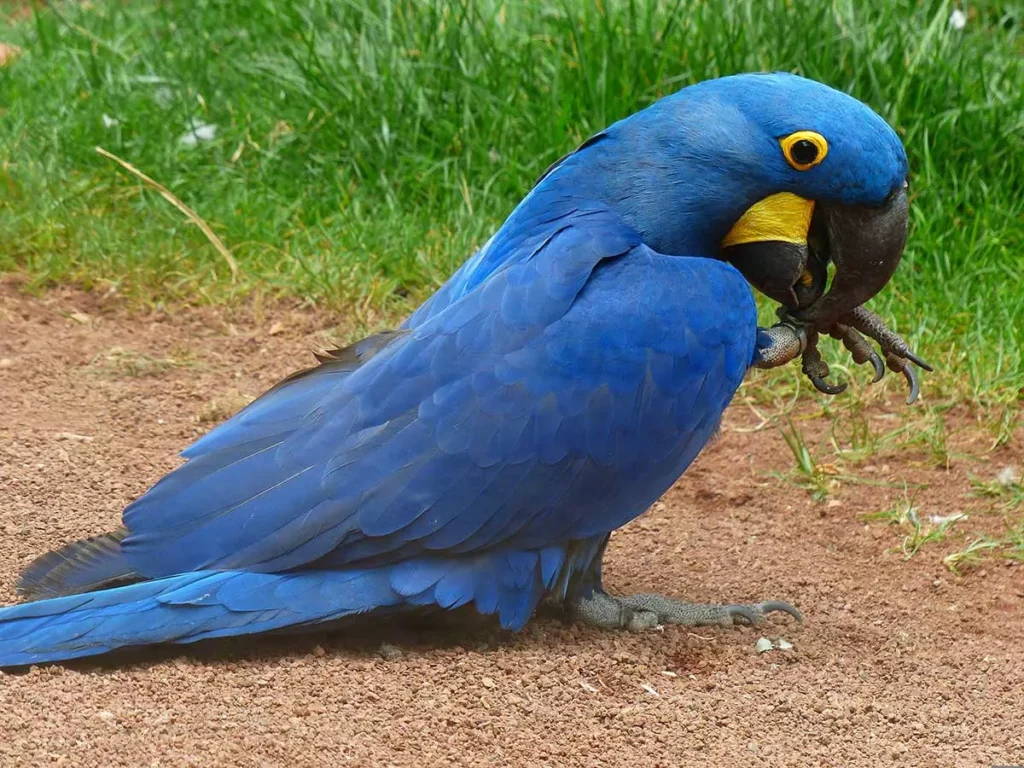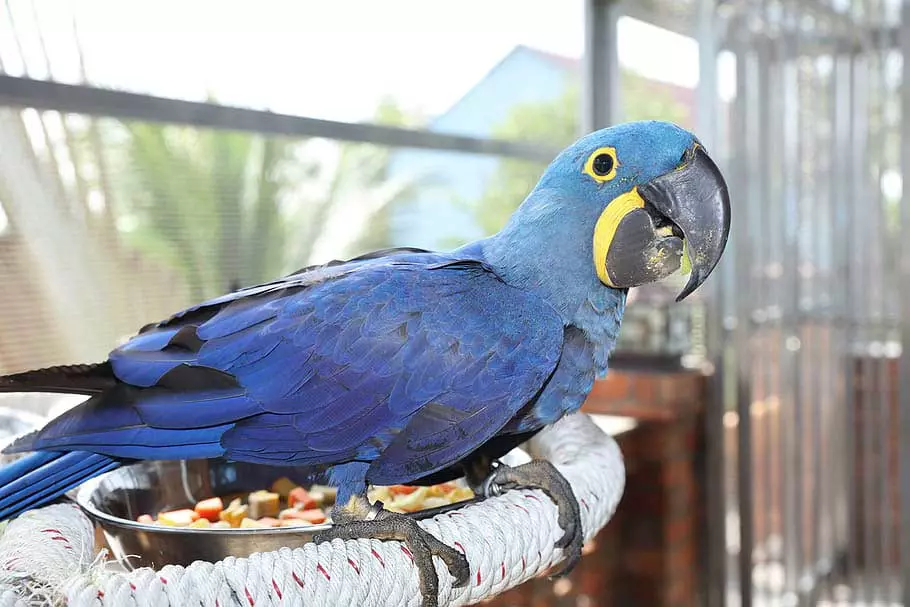
The hyacinth macaw (Anodorhynchus hyacinthinus), also known as the hyacinthine macaw, is a majestic and beautiful bird that captivates bird enthusiasts and parrot lovers alike. Known for its vibrant blue plumage, large size, and powerful beak, this fascinating creature is the largest flying parrot species in the world. However, the hyacinth macaw is also a threatened species, facing numerous challenges in the wild. In this comprehensive guide, we will explore the hyacinth macaw’s natural history, behavior, diet, and conservation status, as well as the unique challenges and joys of owning one as a pet.
Hyacinth Macaw Description
Size and Appearance
The hyacinth macaw, also called blue macaw, is a truly impressive bird, with a length of up to 100 cm (39 inches) and a wingspan of about 150 cm (59 inches). Its striking blue plumage ranges from a rich cobalt to a lighter sky blue, and its long pointed tail and bright yellow eye ring give it a distinctive appearance. The hyacinth macaw’s beak is large and powerful, capable of cracking the hardest of nuts and even crack coconuts.
Habitat
This magnificent bird thrives in a variety of habitats, including palm swamps, savannah grasslands, flooded grasslands, and lightly forested areas. They can be found nesting in tree cavities and cliff faces.
The hyacinth macaw is native to the tropical regions of eastern South America, with populations primarily found in the Pantanal region of Brazil, eastern Bolivia, and northeastern Paraguay.

Behavior and Intelligence of Hyacinth Macaws
These birds are highly social and often seen in pairs or small family groups. Hyacinth macaws are known to be gentle and affectionate, earning them the nickname “gentle giants” among bird enthusiasts.
Hyacinth macaws use a variety of vocalizations, including screeches, squawks, and growls, to communicate with each other. They also use body language, such as fluffing their feathers and bobbing their heads, to convey their emotions.
As an intelligent bird, the hyacinth macaw is known for its problem-solving abilities and capacity to learn tricks. They are also skilled mimics, able to imitate human speech and other sounds, although they may not be as adept at this as some other parrot species.
Diet and Feeding of Hyacinth Macaws
Natural Diet
In the wild, the hyacinth macaw’s diet primarily consists of nuts from acuri and bocaiuva palms, as well as fruits, seeds, and occasionally vegetables. Their powerful beak is perfectly adapted for cracking open the hard shells of these nuts, including brazil nuts and macadamia nuts.
Feeding in Captivity
In captivity, a hyacinth macaw’s diet should be carefully balanced to meet their nutritional needs. This typically includes a mix of parrot pellets, nuts, fruits, and vegetables. It is important to provide them with a variety of nuts to maintain their beak health and ensure they receive the necessary nutrients.

Breeding and Reproduction
Hyacinth macaws typically form strong, monogamous bonds with their mates. During the breeding season, they will search for suitable nesting sites in tree cavities or cliff faces. They may also use artificial nests provided by conservation initiatives.
A female hyacinth macaw will lay one to two eggs, which she incubates for approximately 30 days. The male assists in feeding and protecting the nest during this time. Once the chicks hatch, both parents take turns feeding and caring for their young hyacinth macaw offspring. The chicks fledge at around 110 days, but may remain dependent on their parents for several months after leaving the nest.
Threats to the Hyacinth Macaws
Habitat Loss
Habitat destruction is one of the most significant threats facing hyacinth macaws. Deforestation, cattle ranching, mechanized agriculture, and exotic tree plantations have all contributed to the loss of their native palm swamps, wooded habitats, and lightly forested areas, which are home to specific palm species essential for their survival. This has resulted in fragmented populations and reduced breeding success, making these gentle giants vulnerable to aggressive bird species encroaching on their territory.
Illegal Pet Trade
The illegal pet trade has taken a heavy toll on wild hyacinth macaw populations. Their stunning appearance and gentle nature make them highly sought after as pet birds, and they are often captured from the wild and sold on the black market. This not only reduces their wild population numbers but also puts these birds at risk of abuse and neglect in captivity.
Disease
Macaw wasting disease, also known as proventricular dilatation disease, is a potentially fatal condition that can affect hyacinth macaws, as well as other macaw species. This disease damages the nerves controlling the bird’s digestive system, leading to weight loss and eventual death if left untreated.

Hyacinth Macaws Conservation Initiatives
Hyacinth Macaw Project
The Hyacinth Macaw Project is a conservation initiative focused on protecting and preserving the species, considered as endangered, in their natural habitat. The project’s efforts include habitat restoration, artificial nest installation, and population monitoring of these wild birds to ensure the survival of this endangered species.
Habitat Restoration
Conservation organizations and local communities have worked together to restore hyacinth macaw habitat by planting native palms and other tree species essential to the bird’s survival. This helps to support healthy populations and promote breeding success in the wild.
Captive Breeding Programs
Captive breeding programs have been established to help maintain the species’ genetic diversity and ensure a healthy population of hyacinth macaws for future reintroduction efforts. These programs carefully manage breeding pairs to prevent inbreeding and genetic disorders.
Caring for a Hyacinth Macaw as a Pet
Housing and Space Requirements
Hyacinth macaws require a significant amount of space due to their large size and long pointed tail. Parrot cages for these birds should be sturdy and spacious, with dimensions of at least 8 feet in length, 4 feet in width, and 6 feet in height. Additionally, they should have access to a safe, outdoor aviary or a dedicated room where they can stretch their wings and exercise.
Socialization and Enrichment
Hyacinth macaws are highly social and intelligent birds that require mental and physical stimulation to thrive in captivity. They enjoy interacting playfully with their human caretakers and should be provided with a variety of toys, perches, and chewable objects to keep them engaged. They also benefit from regular socialization with other birds or humans, as well as consistent training and positive reinforcement.
Diet and Nutrition
As mentioned earlier, a hyacinth macaw’s diet in captivity should consist of a balanced mix of parrot pellets, nuts, fruits, and vegetables. Providing a variety of nuts, such as brazil nuts, macadamia nuts, and walnuts, is essential for maintaining their beak health and meeting their nutritional needs. Additionally, fresh fruits and vegetables should be offered daily to ensure a well-rounded diet.
Health and Veterinary Care
Regular health exams are crucial for maintaining the well-being of a hyacinth macaw in captivity. A specialized avian veterinarian should examine the bird at least once a year to ensure good health and address any potential issues early on. Common health concerns for hyacinth macaws include overgrown beaks, which may require trimming, and susceptibility to macaw wasting disease.
The Future of Hyacinth Macaws
While the hyacinth macaw remains a threatened species, ongoing conservation efforts have had a positive impact on their wild populations. Habitat restoration, artificial nest installation, and captive breeding programs have all contributed to stabilizing their numbers and improving their conservation status. Continued support for these initiatives, as well as efforts to combat illegal pet trade and habitat destruction, will be essential for ensuring the long-term survival of this magnificent bird species.

Conclusion
The hyacinth macaw, also known as the anodorhynchus hyacinthinus or hyacinthine macaw, is an incredible and unique parrot species among the macaw species that has captured the hearts of bird enthusiasts around the world. With its vibrant blue feathers, gentle disposition, and impressive intelligence, it’s easy to see why they are so highly prized as pets. However, it’s important to remember the challenges these birds face in the wild, from habitat loss to illegal pet trade. By supporting conservation initiatives and responsible pet ownership, we can help ensure a brighter future for these gentle giants of the parrot world.
